
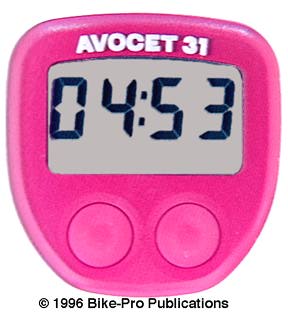
The Avocet 31 is the descendant of the Avocet 30 which is, most likely,the most popular cyclometer ever made. The original 30 model had a different case. Avocet to reduce manufacturing costs, uses for the 31 model, the case they designed and have used for the Avocet 40 model. The Liquid Crystal Display on the 31 is like that in the 40, in that it's fixed to the small printed circuit board mounted in the bottom of the case. The 30 model had the display as a separate piece on the back of the upper case and received it's display information through surface contacts from the rear board to the back of the display bezel. The 40 case with the mounted on board display, is a more reliable information transmission system.
The case for the 31 is two pieces that snap together, Avocet wraps the entire joining surfaces with a tight fitting rubber O-ring to keep the unit water resistant. The 31 is small, lightweight and has a simple, easily readable single line display, with 10mm tall characters, for it's 6functions. The Avocet 31 uses a MultiPulse transmitter for it's frontwheel magnetic sensor system. There are 20 pulses received by the magnetic pick-up, from the magnetic ring, which the computer head divides down to gain a more accurate reading of wheel movement. The 31 comes with a ring that relies on you to have a 36 spoke wheel to work accurately. If you have other than 36 spokes, on your sensored wheel, you will need to buy separately, the other transmitter ring, for use with a 24, 28, 32, 40, or 48 spoke wheel. The Avocet 31 has a 12 hour clock, and
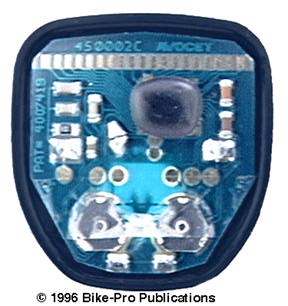
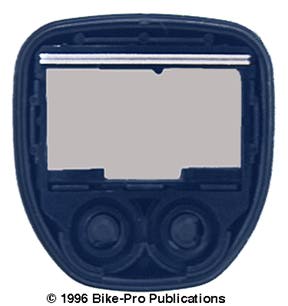
MODEL 31 WITH CASE OPEN
a 1 hour stopwatch (or timer), that increments to 1 hour then resets automatically. All distance readings can be displayed in Miles Per Hour or Kilometers Per Hour. It displays your current speed (up to 67 MPH or 108 KPH) and is accurate to within 0.5 MPH. There is a resettable trip meter, which will display your distance, to the tenth mile/kilometer, since last trip reset (up to 999.9 miles or kilometers traveled). The stopwatch and trip meter are integrated to provide you with your maximum speed during the trip, to the 1/10 MPH/KPH. The 31 has an odometer which displays total distance traveled, up to 9999 miles or kilometers, then reset automatically. The 31 uses a 28" long wire to a front-mounted, wheel sensor, and relies on several tight fitting zip ties to mount the wheel sensor on magnetic ring firmly to the fork blade, (regardless of the diameter), and wheel spokes. The Avocet 31 instruction manual is printed English only, with pict-o-grams to assist in installation. The 31 uses one PX675, 1.36 volt watch battery. The 31 can be quick programmed for wheel size diameters from 20 x 1.75" to 27 x 1/14", and has a quick release handlebar mount, so the computer head can be taken with you to prevent theft, or used on another bike.
The Avocet 31 with all necessary mounting hardware weighs 44 grams. It comes in Blue, Black, Celeste (for you Bianchi road bike owners), Neon Green, Grey, Neon Pink, Lavender, Red, and Neon Yellow. Avocet also made the 31 in what they call "Splatter" colors, where paint has been splattered, or dripped on the case, we think this is transitory and have elected not to sell them. Made in the USA. The 31 has been discontinmued and superceded by the Model 35 which is very similar.
The Model 35 is the newer variation of the 30/31. The Avocet 35 has a single large 10mm tall display line and comes with an Oversize Fork mount that will fit on to any fork. The displayed functions are; Current Speed, Maximum Speed (per ride), Average speed, Trip Distance, Total Distance, Stopwatch (timer) and 12/25 hour clock. It has Auto start/stop and a Pace Arrow function which shows if your present speed is above or below the average speed for the ride. Includes 2 wheel sensors holders to work on any spoke quantity or pattern. It has a total on the bike weight of 53 1/2 grams. Blue, Black, Purple, Red, White. $ Price in Catalog
The Avocet model 40/45 is visually similar, but has some added electronic features over the model 31. The 40 as we have said uses the same water tight case the 31 uses, and it has a circuit board mounted Liquid Crystal Display, in the case of the 40 it is a two line display, The upper line characters are 8mm tall, while the lower line is 5mm tall. Like the model 31 it comes a Multipulse front wheel sensor, with heightened accuracy, it also comes stock with a transmitter ring that reads accurately only a 36 spoke wheel. If your wheel has 24, 28, 32, 40, or 48 spokes you will need to buy separately the other transmitter ring, below. The Avocet 40 has a 12/24 hour clock, which is displayed on the lower line, that you set to display the common "civilian" 12 hour time or can set to display military 24 hour time. The 40 has an upgraded 10 hour stopwatch, accurate to the second, that is displayed on the upper line, after 10 hours it resets automatically. All distance readings can be displayed in Miles Per Hour or Kilometers Per Hour. It displays your current speed (up to 128 MPH or 206 KPH), on the upper line. There is a resettable trip meter, displays on the upper line, your trip distance, to the hundredth mile/kilometer, since last trip reset (up to 1999.9 miles or kilometers traveled). The stopwatch and trip meter are integrated to provide you with your maximum speed, on the lower line, during the trip, to the 1/10 MPH/KPH. It also has average speed available on the lower line, to the tenth MPH/KPH. Because it keeps a running record of your average speed, Avocet has included a feature they call the "Pace Arrow". A small lower line arrow points upward when your current speed exceeds your average speed, in essence you are ahead of your pace, and it points downward when your current speed is below your average speed, so you can pick up your pace.
The 40 has an odometer displayed on the lower line, telling you total distance traveled, up to 19999 miles or kilometers, then reset automatically. The 40 uses a 28" long wire to a front-mounted, wheel sensor, and relies on several tight fitting zip ties to mount the wheel sensor on magnetic ring firmly to the fork blade, (regardless of the diameter), and wheel spokes. The Avocet 40 instruction manual is printed English only, with pict-o-grams to assist in installation. The 40 uses one PX675, 1.36 volt watch battery. The model 40 can be quick programmed for wheel size diameters from 20 x 1.75" to 27 x 1/14", and has a quick release handlebar mount, so the computer head can be taken with you to prevent theft, or used on another bike. The Avocet 40/45 with all necessary mounting hardware weighs 44 grams. The Model 40 has been superceded by the model 45.
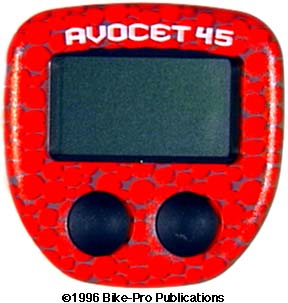
The Avocet 45 has the same functions as the 35 with a few additions. It gives you cadence, if you buy the optional cadence kit, and it has a Gear-Inch calculator that again requires the optional cadence kit. Gear inch is the distance your bike travels per each revolution of the crank and should vary with the gears. This function will allow you to learn where gear ratio overlap occurs in your drivetrain. Once you become familiar with it you will be able to look at your display and know the exact gear you are in. The 45 has a 2 line display. The larger, 8.5mm tall, upper line is used for Current speed, Trip Distance, or Ride time (stopwatch). The other functions are shown on the lower 5mm tall line. The 45 also allows you to have one split average time and distance. Includes new oversize fork mount and wheel sensors holders to work on any spoke quantity or pattern. It has a total weight on bike of 53 grams. Blue, Black, Purple, Red or White.$ Price in Catalog
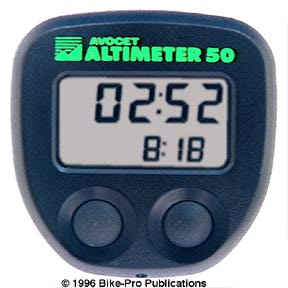
The Avocet 50 features an altimeter, that Robin, who works here, has found he can't live without on his Mount Tamalpais rides each Sunday. It will measure to 19,990 feet above or 990 below sea level, using a barometric pressure sensor, that is adjustable should changing barometric, weather conditions require it. It presents your climbs or descents per trip in 10 foot up or down increments, and they are accumulated only while the wheel is turning, (no cheating by driving up to show every body "what you did"). The 50 also keeps a total climb/descent record as well as the trip record for display, up to 1,999,000 feet in 100 foot increments. The 50 has a two line Liquid Crystal Display, the upper line has characters that are 9mm high, the lower has 5mm characters. Your current altitude is displayed on the upper line, while your total climb/descent is displayed simultaneously on the lower line.
The 50 has many of the "normal" functions. All distance readings can be displayed in Miles Per Hour or Kilometers Per Hour. The 50 has a 12 hour digital clock, on the lower line, while displaying on the upper line, a stopwatch that will run elapsed time up to 1:59:59. There is a resettable trip meter, displayed on the upper line, that will tell you trip distance, up to 1999 miles, to the nearest 1/10th in mile. While the trip distance is displayed the lower line displays an odometer which shows the total distance covered since last reset up to 19,999 miles (where it turns over). The 50 displays your current speed, up to 128 MPH or 206 KPH, on the upper line. The stopwatch and trip meter integrate to tell you the maximum speed you achieved this trip and your average speed for the trip. These two functions are displayed on the lower line.
A unique function integrated into the tripmeter and stopwatch, for performance sake, is what Avocet calls the "PaceArrow". It is two arrows, one pointing up and one pointing down on the display that indicate whether your current speed is above or below your average speed. If you current speed is greater than your average speed the arrow points up, if you are going slower than your average speed the arrow points downward, so you know to pick up your pace. Avocet has an optional cadence sensor for the 50, available separately, which uses a normally unused wire pair into the mounting bracket on the computer, that will display on the lower line, crank RPM from 15 to 240 turns per minute.
The Avocet 50 use a Multipulse magnetic wheel on the front wheel. The one that comes stock with the 50 is for use with a 36 spoke wheel only. If your\ wheel has 24, 28, 32, 40, or 48 spokes you will need to buy separately the other transmitter ring, below. The 50 uses a 28" long wire to a front-mounted, wheel sensor, and relies on several tight fitting zip ties to mount the wheel sensor on magnetic ring firmly to the fork blade, (regardless of the diameter), and wheel spokes. The Avocet 50 instruction manual is printed English only, with pict-o-grams to assist in installation.
The 50 uses two 386, 1.5 volt watch batteries, with an average useful life of 1 1/2 to 2 years. The model 50 can be quick programmed for wheel size diameters from 20 x 1.75" to 27 x 1/14", and has a quick release handlebar mount, so the computer head can be taken with you to prevent theft. The Avocet 50 with all necessary mounting hardware weighed 59 grams. Avocet discontinued the 50, it was described casually as being problem prone.
This is the mounting shoe for the computer, the front wheel sensor, and the 28" is joining wire all factory ready for immediate installation. This can be used to replace a faulty wire assembly, or you can use a separate wire harness on each of several bikes and merely move the computer head to the one you are going to use. It includes several zip ties to fasten the wire and sensor down. It also includes the 36 spoke wheel transmitter, if your monitored wheel has other than 36 spokes you will need the other transmitter ring below. This kit is for use with the Avocet model 20, 30, 31 and 40 computers, also the Altimeter 50 provided you don't use the cadence function. $ Price in Catalog
Many people train in their home during the winter, on a trainer, that requires the front wheel be removed, to remain stable, this wire harness lets you mount the sensor on the rear wheel and runt the wire down the left chainstay, so you can use your computer while training. This is the part as above however, the wire joining the sensor and computer is 55" long and the sensor mounting bracket is a little more substantial. Included are several zip ties to fasten the wire down. It also comes with the 36 spoke wheel transmitter, if your monitored wheel has other than 36 spokes you will need the other transmitter ring below. This kit is for use with the Avocet model 20, 30, 31 and 40, also the Altimeter 50 provided you don't use the cadence function. $ Price in Catalog
The stock magnetic wheel ring that comes with all Avocet computers is for 36 spoke wheels only, and has three locking tabs that snap around the hub flange. Avocet, has a separate magnetic wheel ring for use on 24, 28, 32, 40 or 48 spoke wheels, and is identifiable because it has four of the locking tabs to space equidistantly around the hub flange. If your monitored wheel is other than 36 spoke,for a proper fit you will need this magnetic ring. $ Price in Catalog
The cadence kit is a separate, and new wire harness for the Altimeter 50 and the 45. The kit includes a small magnet that adheres to your crank arm and another magnetic sensor that fasten to your left chainstay. The cadence pulse comes to the computer head through a pair of wires that share a common ground, and one extra pin on the quick release, computer mounting bracket. The kit includes the cadence sensor, cadence magnet, wheel sensor, and computer mounting bracket, all pre-wired to work together immediately. There are also several zip ties to fasten all the wires to your frame. Black only $ Price in Catalog
The Avocet 20 & 30 computers use a single RM41 1.5 volt battery. The replacement battery comes with a quick entry re-calibration chart, to re-enter your wheel diameter information since it will be lost when the battery fails. $ Price in Catalog
This isn't a cycling computer, and strickly speaking, there is no obvious category for this device, which is why we are describing it in unusual (even for us) detail. It integrates time, and temperature, with altimetric functions derived from changes in the barometric air pressure. Though the device is sold in two models, they are electronically the same, in the ascent/descent mode there is a set-up function which toggles between the Alpine or Ski model functionality. Since any Vertech can be both an Alpine and A Ski model what other differences are there? The model sold as the "Ski" comes with an elastic wrist band, (made of the strap material used to hold ski goggles in place), capable of stretching over a ski glove, the Alpine model comes with a nylon "web" strap of the sort used to hold bicycle to car bicycle carriers. We can't tell you which would be more durable because nearly all else the strap touches, and the central upper case are made of plastic that is more likely to fail.
The display has up to three lines of information that it can present on one passive LCD screen. The upper line has 5mm tall characters, the middle line's characters are 2.5mm tall, and the lower line has characters that are 4mm high. Pressing the "Function " button on the unit's lower left advances the display through the system's main or primary screens, and moves an "_" underline character accross the bottom of the display to show visually which function screen "group" you are using.
Pressing the "Option" button on the lower right, presents variations on the presently displayed functions. we will describe the Vertech now, by function screen and variation. The Altitude/Clock screen displays your present altitude on the upper line from -4,000 to +60,000 feet in 10 feet increments. The middle line displays the present temperature in whole degrees using either the Fahrenheit or Celcius scale. The lower line of this screen displays the current time, in either a 12 or 24 hour format. Pressing the option button on this screen changes the upper line to show the date and lower line displays the time that the Vertech's settable 24 hour alarm is set for.
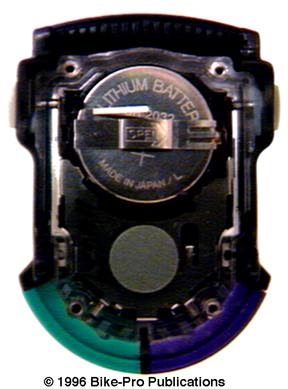
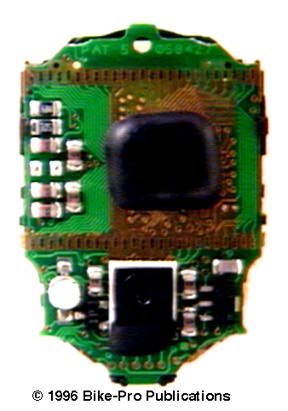
REAR VIEW INSIDE
The alarm can be used as a wake-up alarm or a reminder of appointments. Pressing the option button once more, displays on the upper line the highest point or maximum altitude that Vertech has been to within 10 feet, while the lower line displays a 24 hour settable countdown timer. The countdown timer is set with the function button then initiated by pressing the start/stop button. It decrements in whole seconds and sounds an alarm when it reaches zero.
Pressing the Function button once advances to the Ascent/Descent primary screen which presents altimetric information. There is no difference between the Alpine and Ski models of the Vertech, in this screen an adjustment can be made to change the Vertech to either type of unit. We will first describe it as an Alpine set instrument. In the first screen, the upper line displays the daily change in Ascent/Descent with a ten foot resolution, while the lower line shows the change in Ascent/Descent in feet per hour with a 100 foot per hour resolution.The daily rates can reset to zero at any time. The display of the change in altitude as a rate of descent or ascent is selectable. The second screen, on the upper line displays the total Ascent/Descent accumulated on the instrument since last total reset or reaching 299,990 total feet when it resets automatically, in a 10 foot resolution. The lower line in the second screen maintains the maxiumum vertical rate of ascent since the last reset in feet per hour with a 100 foot resolution. It will not record the maxmium rate of descent. The third, and last of the Ascent/Descent screens, incorporates the timer or stopwatch function into the rate of climb.
Pressing the start/stop button begins a timer which will time your ascent. On the upper line, the elapsed time is displayed, and on the lower line your average rate of climb over the timed interval is displayed to a 10 foot per hour resolution. Now, the differences on the displays if the Vertech were set to "Ski" functionality. As a Ski unit, it will show the altitude changes in feet per minute rather than hour, and will count the number of "runs" (skied hilltop descents) skied. The resolution tightens up to 50 FPM in the current and max rates and 10 FPM in the average mode. The current rate of Descent (or Ascent) is calculated from a moving average, which is weighted from data derived from the last 30 seconds of performance, in essence extrapolating your likely current performance based on significant changes in the past 30 seconds.
Pressing the Function button brings the weather screen up. Using an internal sensor/converter chip labeled "9250 ATMOS 76007CM", the Vertech detects the current air pressure. The sensor, for altitude functions, measures the altitude climbed or descended as a change in the relative air pressure, converting the analog air pressure to a digital display of rate climb or descent. The same sensor is employed to detect what can be termed as "Baromaetric air pressure". Assuming that you don't change your altitude, and you have set the barometer aspect of the Vertech to the local altitude, the upper display shows the sea level baromater in inches of mecury, the middle display shows current temperature, and the lower display shows the current barometeric trend in decimal inches of mercury with a plus (+) or minus (-) sign to indicate whether it is rising, (showing a tendency to better weather), or falling (indicating a lower pressure, toward stormy conditions) mercury. Pressing the Function button again brings up the Timer screen. Pressing the start/stop button begins the timer, with the elapsed time displayed on the upper line to the 5/100th second, during the first hour then turns to full seconds until 24 hours have passed, when it resets. Pressing the Option button invokes a "split" routine, moving the total elapsed time to the lower line and displaying the time to the 5/100th since pressing the Option button on the upper line. In essence displaying the "split" from totla time on the upper line. Each succesive pressing of the Option button, concludes or stops the time on the last split and creates a new split. The number of the present split is displayed in the middle line, (where we have seen the temperature in previous functions). Up to 20 splits may grouped and stored into the units memory for display at a later date. Each saved split shows the split number, total elapsed time, and the split time. The Vertech relies on a single CR2032 lithium battery, that is field replaceable provided you have a jewelers screwdriver set.
The Vertech has an O-ring that seals the rear access of inner case. The altimetric/barometric sensor detects air pressure through an opening in the face of the case, though the Vertech is said to be water resistant to 10 feet this air pressure hole is the likely entrance for moisture as water or vapor. Wrist ready, the Ski model weighs 37.5 grams, and the Alpine weighs 39 grams. Although the Vertech is made in Black and a "Charcoal" color, we only sell the Black. Made in the Silicon Valley area of Northern California. $ Price in Catalog
